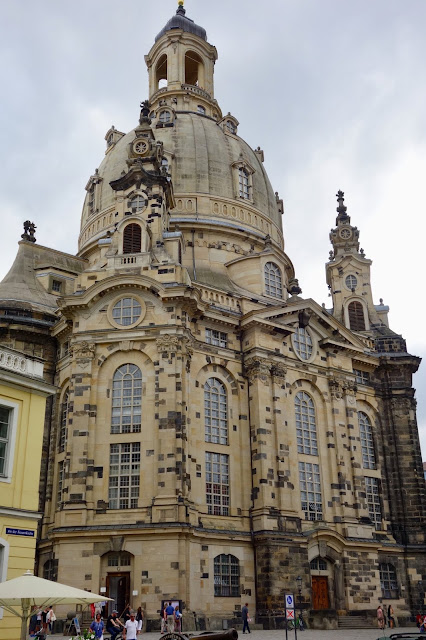My sister and I had only two days to explore downtown Dresden.
Everything is centrally located so we could see it all in two days.
One wing of the Zwinger Palace is a science-mathematics museum. Inside was a Gregorian Reflecting Telescope made by Johann Gottlob Rudolph about 1748. Amazing beauty (inside a case, hard to photo).
More amazing was a gigantic standing clock, an Augsburg Art Cabinet, housing a clock made by Matthaus Rungel, made about 1625.
Inside is a harpsichord and organ that plays music via a pinned cylinder while white Europeans and black people jump up and down, in a circular movement on the terrace. I asked myself, "What were these people thinking back in the 17th Century?"
Downtown is pedestrian only which is why it's both relaxing and pleasant to walk around this "Jewel Box" of a city.
Humongous doors . . .
Below photo is the Frauenkirche church which was left in ruins for 50 years after the WWII bombing and then in 1994 work began to restore the exterior which was completed ten years later.
Inside, the restoration is beautiful (finished in 2005).
This church was the setting for a performance by Vittorio Grigolo. There are only two male singers who can knock my socks off, Vittorio Grigolo and Mark Knopfler. Click here to see Vittorio's Ave Maria song performed in this incredibly beautiful church, November 2010.
Vicki and I ate at an "authentic" German restaurant, on their outdoor patio, overlooking the restored Frauenkirche.
I have to admit however this was our last "authentic" German meal; neither of us enjoys salty processed meat and mashed potatoes. Vicki's facial expression says it all.
But the ambiance and location were most enjoyable.
This 34-feet high and 334-feet long wall (photo below shows only a small portion) is composed of 23,000 porcelain tiles that are individually about 8 x 8 inches.
From left to right, it depicts 800 years of Saxony rulers mounted on their horses. Click here for an explanation and more photos of the largest porcelain artwork in the world.
Across the Elbe River is the Japanisches Palais. We didn't have time to visit there; zoomed photo shows a summer music program.
The Elbe River runs through Dresden and cuts through the entire country of Germany. It's a slow moving relaxing river in Dresden. See the bicycle on the roof of this home-made pontoon?
Dresden fortunately remains Germany's "Jewel Box".
The next day Vicki and I walked back to the bus station and boarded a bus to Prague (Czech Republic). It's only a two-hour bus ride through scenic rural areas and oddly, no border check.
PS: I haven't mentioned the number of annoying smokers we encountered. An unbelievable number of people smoked on the sidewalks and while eating and drinking at outside restaurants in Berlin and Dresden. I did research and Germany ranks 33 in cigarette consumption of 182 countries. For comparison, the United States ranks 69 of 182 countries. The next country we visited, Czech Republic, ranks 8 of 182 countries. The smoking around us only gets worse :(
























No comments:
Post a Comment